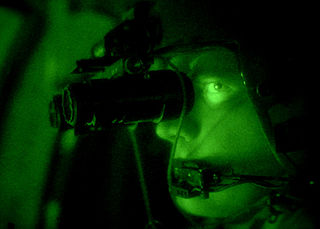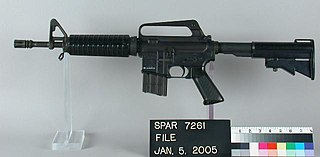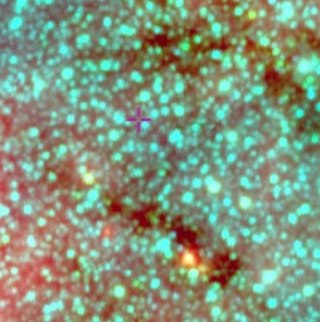Related Research Articles

In electronics, a remote control is an electronic device used to operate another device from a distance, usually wirelessly. In consumer electronics, a remote control can be used to operate devices such as a television set, DVD player or other home appliance. A remote control can allow operation of devices that are out of convenient reach for direct operation of controls. They function best when used from a short distance. This is primarily a convenience feature for the user. In some cases, remote controls allow a person to operate a device that they otherwise would not be able to reach, as when a garage door opener is triggered from outside.

Night vision is the ability to see in low-light conditions, either naturally with scotopic vision or through a night-vision device. Night vision requires both sufficient spectral range and sufficient intensity range. Humans have poor night vision compared to many animals such as cats, foxes and rabbits, in part because the human eye lacks a tapetum lucidum, tissue behind the retina that reflects light back through the retina thus increasing the light available to the photoreceptors.

A thermographic camera is a device that creates an image using infrared (IR) radiation, similar to a normal camera that forms an image using visible light. Instead of the 400–700 nanometre (nm) range of the visible light camera, infrared cameras are sensitive to wavelengths from about 1,000 nm to about 14,000 nm (14 μm). The practice of capturing and analyzing the data they provide is called thermography.

A frogman is someone who is trained in scuba diving or swimming underwater in a tactical capacity that includes military, and in some European countries, police work. Such personnel are also known by the more formal names of combat diver, combatant diver, or combat swimmer. The word frogman first arose in the stage name The Fearless Frogman of Paul Boyton in the 1870s and later was claimed by John Spence, an enlisted member of the U.S. Navy and member of the OSS Maritime Unit, to have been applied to him while he was training in a green waterproof suit.

A night-vision device (NVD), also known as a night optical/observation device (NOD), night-vision goggle (NVG), is an optoelectronic device that allows visualization of images in low levels of light, improving the user's night vision. The device enhances ambient visible light and converts near-infrared light into visible light which can be seen by the user; this is known as I2 (image intensification). By comparison, viewing of infrared thermal radiation is referred to as thermal imaging and operates in a different section of the infrared spectrum. A night vision device usually consists of an image intensifier tube, a protective housing, and may have some type of mounting system. Many NVDs also include a protective sacrificial lens, mounted over the front lens (ie. objective lens) on NVDs to protect the latter from damage by environmental hazards and some can incorporate telescopic lenses. The image produced by an NVD is typically monochrome green, as green was considered to be the easiest color to look at for prolonged periods in the dark. Night vision devices may be passive, relying solely on ambient light, or may be active, using an IR (infrared) illuminator to better visualize the environment.

Laser tag is a recreational shooting sport where participants use infrared-emitting light guns to tag designated targets. Infrared-sensitive signaling devices are commonly worn by each player to register hits and are sometimes integrated within the arena in which the game is played.

Combined Operations Headquarters was a department of the British War Office set up during Second World War to harass the Germans on the European continent by means of raids carried out by use of combined naval and army forces.

A sight or sighting device is any device used to assist in precise visual alignment of ranged weapons, surveying instruments or optical illumination equipments with the intended target. Sights can be a simple set or system of physical markers that serve as visual references for directly aligning the user's line of sight with the target, or optical instruments that provide an optically enhanced — often magnified — target image aligned in the same focus with an aiming point. There are also sights that actively project an illuminated point of aim onto the target itself so it can be observed by anyone with a direct view, such as laser sights and infrared illuminators on some night vision devices, as well as augmented or even virtual reality-enabled digital cameras with software algorithms that produce digitally enhanced target images.

An infrared thermometer is a thermometer which infers temperature from a portion of the thermal radiation sometimes called black-body radiation emitted by the object being measured. They are sometimes called laser thermometers as a laser is used to help aim the thermometer, or non-contact thermometers or temperature guns, to describe the device's ability to measure temperature from a distance. By knowing the amount of infrared energy emitted by the object and its emissivity, the object's temperature can often be determined within a certain range of its actual temperature. Infrared thermometers are a subset of devices known as "thermal radiation thermometers".
Consumer IR, consumer infrared, or CIR is a class of devices employing the infrared portion of the electromagnetic spectrum for wireless communications. CIR ports are commonly found in consumer electronics devices such as television remote controls, PDAs, laptops, and computers.
Circumstellar dust is cosmic dust around a star. It can be in the form of a spherical shell or a disc, e.g. an accretion disk. Circumstellar dust can be responsible for significant extinction and is usually the source of an infrared excess for stars that have it. For some evolved stars on the asymptotic giant branch, the dust is composed of silicate emissions while others contain the presence of other dust components. According to a study, it is still uncertain whether the dust is a result of crystalline silicate or polycyclic aromatic hydrocarbon. However, recent observations revealed that Vega-type stars display broad silicate emission. It is suggested that the circumstellar dust components can depend on the evolutionary stage of a star and is related to the changes in its physical conditions.

An infrared blaster is a device that relays commands from a remote control to one or more devices that require infra-red remote control. For instance, it may also allow radio-frequency-based (RF) remotes to control infra-red-based components. It may also allow one device to control another: A recording device, such as a DVR or VCR, might change the channel on an external tuner. This way, the receiving device can automatically be set to the correct channel before the recording process starts. An IR blaster can be used to implement remote control of components from a mobile phone, tablet, or computer.
Infrared vision is the capability of biological or artificial systems to detect infrared radiation. The terms thermal vision and thermal imaging, are also commonly used in this context since infrared emissions from a body are directly related to their temperature: hotter objects emit more energy in the infrared spectrum than colder ones.

The LGI Mle F1 is a lightweight, close-support infantry weapon designed to be used by one man to provide indirect fire. The LGI has been used by the French Army since the 1990s and fires high explosive, smoke, and illumination rounds.

The M6 Mortar is a 60 mm lightweight infantry mortar made by Hirtenberger AG of Austria.

Canadian Disruptive Pattern is the computer-generated digital camouflage pattern developed for use by the Canadian Armed Forces. Four operational variations of CADPAT have been used by the Canadian Armed Forces: a temperate woodland pattern, an arid regions pattern, a winter operations pattern, and a multi-terrain pattern.
The attack on USNS Card was a Viet Cong (VC) operation during the Vietnam War. It took place in the port of Saigon in the early hours of 2 May 1964, and was mounted by commandos from the 65th Special Operations Group.

Tabby's Star is an F-type main-sequence star in the constellation Cygnus approximately 1,470 light-years from Earth. Unusual light fluctuations of the star, including up to a 22% dimming in brightness, were discovered by citizen scientists as part of the Planet Hunters project. In September 2015, astronomers and citizen scientists associated with the project posted a preprint of an article describing the data and possible interpretations. The discovery was made from data collected by the Kepler space telescope, which observed changes in the brightness of distant stars to detect exoplanets.

The CAR-15 XM177 or CAR-15 Commando was a part of the CAR-15 Military Weapons System designed in 1966 in response to the US military's desire for a compact M16 variant to improve on the inadequacies of earlier shortened M16 types.

VVV-WIT-07 is a unique variable star which presents a sequence of recurrent dimmings with a possible deep eclipse in July 2012. The star, located in the Scorpius constellation about 23,000 ly (7,100 pc) away, is not a binary star, which would eliminate such a system from explaining the various observed dimmings.
References
- ↑ Ladd, James (1 January 1979). Commandos and Rangers of World War II. p. 242. ISBN 9781131235172.
- ↑ "COPP Survey | Homing and beach marking equipment". COPP Survey.